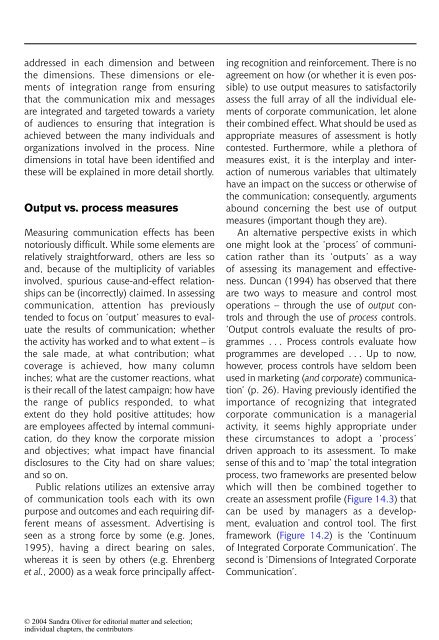Handbook of Corporate Communication and Public ... - Blogs Unpad
Handbook of Corporate Communication and Public ... - Blogs Unpad
Handbook of Corporate Communication and Public ... - Blogs Unpad
You also want an ePaper? Increase the reach of your titles
YUMPU automatically turns print PDFs into web optimized ePapers that Google loves.
addressed in each dimension <strong>and</strong> between<br />
the dimensions. These dimensions or elements<br />
<strong>of</strong> integration range from ensuring<br />
that the communication mix <strong>and</strong> messages<br />
are integrated <strong>and</strong> targeted towards a variety<br />
<strong>of</strong> audiences to ensuring that integration is<br />
achieved between the many individuals <strong>and</strong><br />
organizations involved in the process. Nine<br />
dimensions in total have been identified <strong>and</strong><br />
these will be explained in more detail shortly.<br />
Output vs. process measures<br />
Measuring communication effects has been<br />
notoriously difficult. While some elements are<br />
relatively straightforward, others are less so<br />
<strong>and</strong>, because <strong>of</strong> the multiplicity <strong>of</strong> variables<br />
involved, spurious cause-<strong>and</strong>-effect relationships<br />
can be (incorrectly) claimed. In assessing<br />
communication, attention has previously<br />
tended to focus on ‘output’ measures to evaluate<br />
the results <strong>of</strong> communication; whether<br />
the activity has worked <strong>and</strong> to what extent – is<br />
the sale made, at what contribution; what<br />
coverage is achieved, how many column<br />
inches; what are the customer reactions, what<br />
is their recall <strong>of</strong> the latest campaign; how have<br />
the range <strong>of</strong> publics responded, to what<br />
extent do they hold positive attitudes; how<br />
are employees affected by internal communication,<br />
do they know the corporate mission<br />
<strong>and</strong> objectives; what impact have financial<br />
disclosures to the City had on share values;<br />
<strong>and</strong> so on.<br />
<strong>Public</strong> relations utilizes an extensive array<br />
<strong>of</strong> communication tools each with its own<br />
purpose <strong>and</strong> outcomes <strong>and</strong> each requiring different<br />
means <strong>of</strong> assessment. Advertising is<br />
seen as a strong force by some (e.g. Jones,<br />
1995), having a direct bearing on sales,<br />
whereas it is seen by others (e.g. Ehrenberg<br />
et al., 2000) as a weak force principally affecting<br />
recognition <strong>and</strong> reinforcement. There is no<br />
agreement on how (or whether it is even possible)<br />
to use output measures to satisfactorily<br />
assess the full array <strong>of</strong> all the individual elements<br />
<strong>of</strong> corporate communication, let alone<br />
their combined effect. What should be used as<br />
appropriate measures <strong>of</strong> assessment is hotly<br />
contested. Furthermore, while a plethora <strong>of</strong><br />
measures exist, it is the interplay <strong>and</strong> interaction<br />
<strong>of</strong> numerous variables that ultimately<br />
have an impact on the success or otherwise <strong>of</strong><br />
the communication; consequently, arguments<br />
abound concerning the best use <strong>of</strong> output<br />
measures (important though they are).<br />
An alternative perspective exists in which<br />
one might look at the ‘process’ <strong>of</strong> communication<br />
rather than its ‘outputs’ as a way<br />
<strong>of</strong> assessing its management <strong>and</strong> effectiveness.<br />
Duncan (1994) has observed that there<br />
are two ways to measure <strong>and</strong> control most<br />
operations – through the use <strong>of</strong> output controls<br />
<strong>and</strong> through the use <strong>of</strong> process controls.<br />
‘Output controls evaluate the results <strong>of</strong> programmes<br />
. . . Process controls evaluate how<br />
programmes are developed . . . Up to now,<br />
however, process controls have seldom been<br />
used in marketing (<strong>and</strong> corporate) communication’<br />
(p. 26). Having previously identified the<br />
importance <strong>of</strong> recognizing that integrated<br />
corporate communication is a managerial<br />
activity, it seems highly appropriate under<br />
these circumstances to adopt a ‘process’<br />
driven approach to its assessment. To make<br />
sense <strong>of</strong> this <strong>and</strong> to ‘map’ the total integration<br />
process, two frameworks are presented below<br />
which will then be combined together to<br />
create an assessment pr<strong>of</strong>ile (Figure 14.3) that<br />
can be used by managers as a development,<br />
evaluation <strong>and</strong> control tool. The first<br />
framework (Figure 14.2) is the ‘Continuum<br />
<strong>of</strong> Integrated <strong>Corporate</strong> <strong>Communication</strong>’. The<br />
second is ‘Dimensions <strong>of</strong> Integrated <strong>Corporate</strong><br />
<strong>Communication</strong>’.<br />
© 2004 S<strong>and</strong>ra Oliver for editorial matter <strong>and</strong> selection;<br />
individual chapters, the contributors

















